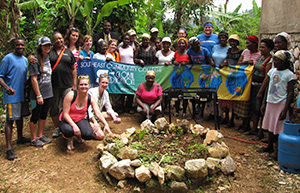SCC students, faculty participate in global education trip to Haiti

December 3, 2014
Political instability, illness, a high unemployment rate, poverty, and natural disasters. Often, these are the negative images Americans have of the Republic of Haiti.
Eleven people representing Southeast Community College, including nine students, recently participated in a 10-day service-learning trip to the Caribbean country. Dr. Bill Waters, SCC’s Global Education coordinator, and Debbie Gaspard, instructor in the Business Administration program, served as co-leaders of the trip, a joint venture between Global Education and SCC’s Business Division.
“Our objective was to understand Haiti from the Haitian perspective versus what you see on the news in the United States,” Waters said. “News about Haiti in the U.S. is almost always negative.”
The group visited innovative businesses, artist communities, worked on two service-learning projects, and viewed damage the country sustained in the 2010 earthquake.
“The reason we visited these businesses and different locations was to show students that there’s more to Haiti than the negative press it receives,” Waters said. “There are positive things happening in the country.”
The service-learning projects were initiated by the Haitian communities, Waters said. The group painted College Rama, an elementary school of approximately 350 students preschool to sixth grade, inside and out, and provided a propane stove that a local women’s coffee cooperative needed.
“In the Global Education class, we talked about the Haitian education system and about coffee production,” said Waters, who has made approximately 40 trips to the country and lived there for a year. “Students need to learn about these things in order to understand the problems and the purpose behind doing the work we did.”
Besides painting, the group from SCC provided supplies and educational games to the school.
The 15-member coffee cooperative, titled Bird Women, was located in the surrounding area of Port-au-Prince. The women grow their own coffee trees, harvest the beans, roast them, and then sell their coffee at the local market. It is their sole source of income, Waters said. He said the women currently roast coffee beans over a wood fire. Using propane saves time and improves the workers’ health.
“Propane is a clean-burning fuel, and the women were becoming ill by inhaling smoke from the wood-burning fire,” Waters said. “Long-term consequences include increased rates of heart attack, stroke and emphysema.”
Waters said a company called Camp Chef donated the propane stove.
“This was exciting for the coffee cooperative, and it was revolutionary,” he said.
The group visited artist communities called Grand Rue Sculptors, which translates as Grand Street, and Croix-des-Bouquets, a commune in the Ouest Department of Haiti.
Grand Rue Sculptors is a collection of artists who make art out of discarded objects that no longer have use, Waters said.
“They repurpose those objects into art,” he said. “They are located in the automotive repair district in the heart of Port-au-Prince. A lot of their art is made with car parts. They are well-known internationally. A lot of the art has symbolic meaning, and that is the reason for making it.”
The artists in Croix-des-Bouquets make art out of discarded 55-gallon drums.
“There are probably 50-60 artists in this community,” Waters said. “Some of the designs are hearts, the tree of life, mermaids, and nativity scenes. Each artist will specialize in one or two motifs. You can find these for sale at Ten Thousand Villages.”
Waters said these artists also are well-known internationally.
The SCC group also visited Surtab, a Port-au-Prince-based company that makes Android tablets, and Papillon Enterprises, a socially and ecologically conscious business with a mission of stimulating the Haitian economy by exporting and marketing Haitian artisan goods.
“Surtab is the first high-end electronics business in Haiti,” Waters said. “Within six months they were able to manufacture a tablet comparable to an iPad mini. It’s quite remarkable.”
In March the company produced 2,500. In April, production increased to between 3,000 and 3,500 units. The company is one of the bright spots in the poorest country in the Western Hemisphere.
“The company pays two-and-a-half to four times the average salary in Haiti,” Waters said. “Women are making $16 per day. It’s also one of first companies in Haiti to offer health care benefits.”
Papillon Enterprises was founded by American Shelley Clay, but it employs local people who make crafts for sale in local boutiques and stores internationally. The company uses recyclable goods to make their crafts.
“They work with recycled paper to make beads and crafts from mined Haitian clay,” Waters said. “They’re trying to demonstrate to the local population that one person’s trash is another person’s jewelry.”
Waters said the SCC students came away with a greater knowledge of Haiti, its people and its culture.
“It helped our students understand the world around them and gave them the opportunity to assist the local community by improving the quality of their lives,” Waters said.
“While poverty is real in Haiti, and environmental problems and political problems are real, there are innovative companies and individuals trying to improve the quality of life for their employees and of their communities,” he said. “They are trying to improve the educational abilities of their students. The coffee women are trying to improve the environment. Beauty exists in Haiti. There are creative minds. People aren’t living day to day, they are living life with a purpose. The creativity and innovation that’s involved are all too often overlooked.”
Although he’s travelled to Haiti with regularity since 1986, Waters said he learns something each trip.
“Every trip is a new experience,” he said. “One of the most exciting things is taking students who have never been there before and learning from them. When you have gone to a place as many times as I have, you tend to overlook things. I’m viewing it through the eyes of my students.”
